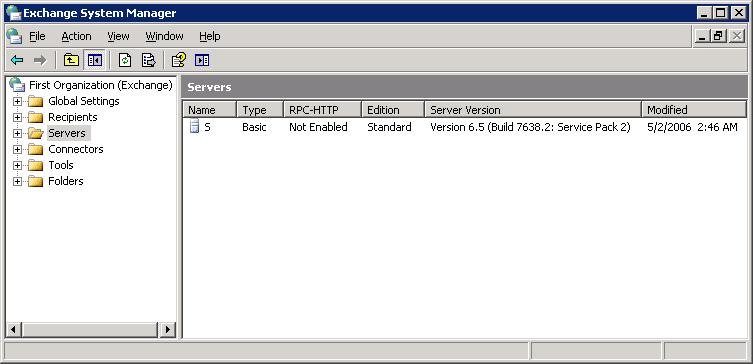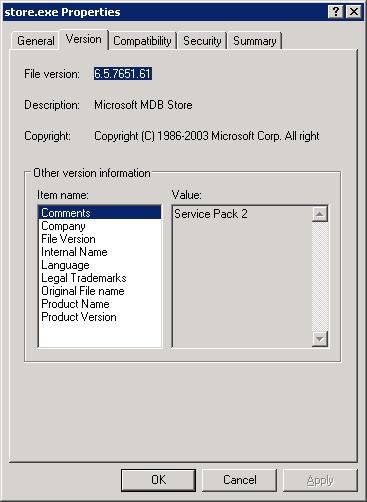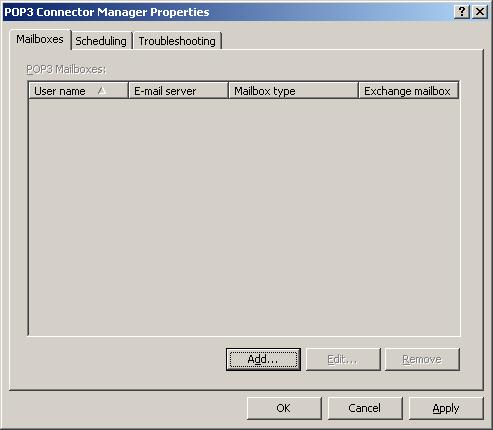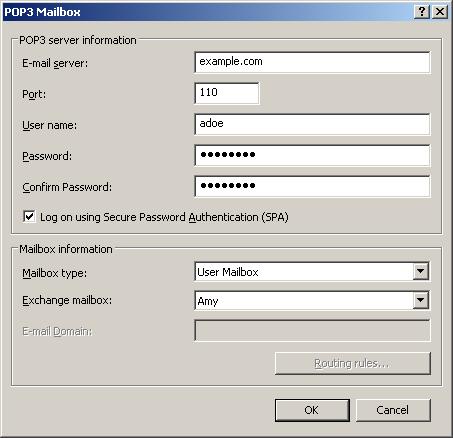←December→
| Sun |
Mon |
Tue |
Wed |
Thu |
Fri |
Sat |
| |
1 |
2 |
3 |
4 |
5 |
6 |
| 7 |
8 |
9 |
10 |
11 |
12 |
13 |
| 14 |
15 |
16 |
17 |
18 |
19 |
20 |
| 21 |
22 |
23 |
24 |
25 |
26 |
27 |
| 28 |
29 |
30 |
31 |
|
|
|
|
|
Thu, Jul 10, 2008 3:57 pm
Turning Off Forwarding in Microsoft Exchange
On a Small Business Server (SBS) 2003 system, to turn off forwarding of email
from Microsoft Exchange 6.5 to an external email address, take the following
steps:
- Click on Start.
- Select All Programs.
- Select Administrative Tools.
- Select Active Directory Users and Computers.
- Under Users, right-click on the appropriate user account and
select Properties.
- Click on the Exchange Advanced tab.
- Click on Delivery Options.
- Under Forwarding Address, select None, instead
of Forward to.
- Click on OK.
- Click on OK to close the Properties window.
[/network/email/exchange]
permanent link
Mon, Apr 28, 2008 9:08 pm
Configuring Microsoft Exchange to Use a Smart Host
If a Microsoft Exchange server doesn't have a
PTR
record, other email servers may reject email from the Exchange server
when they are unable to perform a reverse lookup on the IP address for
the Exchange server. A workaround for this problem is to use a "smart host"
to route outgoing email from the Exchange server.
[ More Info ]
[/network/email/exchange]
permanent link
Sun, Apr 27, 2008 8:30 pm
Store.Exe Consuming Excessive Memory
On a Microsoft Exchange 2003 server, I've found Task Manager reporting high
memory utilization. When I sort the running processes by memory utilization in
the Task Manager (click on the
Performance tab then click on the
Processes column header to sort them), I see
store.exe
consuming over 500 MB. This is happening at the moment on a Sunday evening when
few of the systems in the domain even have Outlook open to check email. The
CPU utilization is low, less than 10% at the moment when I am seeing the 500 MB
memory usage.
I've been seeing memory utilization jumping up to high values a lot lately.
Rebooting the system resolves the problem, but I don't want to be rebooting
the Exchange server every day. I can also reduce the memory utilization by
selecting Run and typing services.msc to bring up the
services list, I can then right-click on Microsoft Exchange Information
Store and stop the service and then restart it. I then see store.exe
using about 20 MB of memory when I check its utilization with the
Windows Task Manager
The Microsoft Exchange Information Store service manages the
Microsoft Exchange Information Store, which includes mailbox stores and
public folder stores. If the service is stopped, mailbox stores and public
folder stores on the computer become unavailable, so it needs to be restarted
immediately after stopping it.
References:
-
Store.exe High Memory Utilization
August 10, 2005
Tech Support, Manuals & Troubleshooting for Consumers
-
Memory leak in Store.exe - pub1.edb GIGANTIC
Server Watch Forums
[/network/email/exchange]
permanent link
Tue, Feb 12, 2008 8:42 pm
Viewing Exchange Logs in Excel
The email log files for a Microsoft Exchange server can be analyzed with
Microsoft Excel. Exchange stores the log entries in a text file, which can
be imported in Excel for analysis.
[
More Info ]
[/network/email/exchange]
permanent link
Thu, Feb 07, 2008 8:01 pm
Determining Version of Microsoft Exchange
To determine what version of Microsoft Exchange is running on
a system, you can take the following steps:
- Click on Start.
- Select All Programs.
- Select Microsoft Exchange.
- Select System Manager. Note: the System Manager
is applicable if you have Exchange Server 2000 and later. For
Exchange Server 5.5 and earlier, you will need to run
Exchange Administrator.
- Click Servers. You will then see the version
displayed. For Exchange Server 2000, the version is 6.0;
for Exchange Server 2003, the version is 6.5.

You can also determine the version number, by going to
C:\Program Files\Exchsrver\bin, right-clicking on
store.exe, selecting Properties, and
clicking on the Version tab.

Clicking on Product version will show the version
of the Exchange software. In the case shown above, the
file version is listed as 6.5.7651.61 while the product version
is 6.5. The digits after the 6.5 in the file version don't
necessarily match the build version displayed using the first
method.
Note: the version number you see using the above methods
may not necessarily be the same version number you would
see displayed if you telnet to port 25 on the Exchange server. E.g.
the above method of determining the version of Exchange running
on a system shows it to be 6.5 (Build 7638.2: Service Pack 2), but
if I telnet to port 25 on that same Exchange server, I see the
following:
220 example.com Microsoft ESMTP MAIL Service, Version: 6.0.3790.3959 ready at
Wed, 13 Feb 2008 19:07:30 -0500
I.e. the "ESMTP MAIL Service" version is not the same as the version number
for the Exchange server software on the system, so you can't infer that
the version number you see displayed when you connect to port 25 on the
system is the Exchange server version number.
References:
-
How to tell which software version your computer is using
Published: June 18, 2004
Microsoft Corporation
[/network/email/exchange]
permanent link
Tue, Aug 28, 2007 11:04 pm
Forwarding Email to Another Exchange User
For an Exchange 2003 server, If you need to forward email to another Exchange
user when an employee leaves, take the following steps.
- Go to Active Directory Users and Computers.
- Select the account for the user who left and right click on it.
- Select Properites.
- Under the Exchange General tab, click on the Delivery
Options button.
- Click on the Modify button at the Delivery Options
window that opens.
- In the "Enter object name to select" field, type the account name of the
user to whom email should be forwarded, e.g. jsmith.
- Click on the Check names button to verify the account name and
then click on OK when it has been verified.
- Click on OK again to close the Delivery Options window.
- Click on OK to close the Properties window.
If you need to forward email to an external address instead of an internal
Exchange address,
see
Forwarding an Exchange User's Email to an External Address.
References:
-
Forwarding an Exchange User's Email to an External Address
November 5, 2006
MoonPoint Support
-
Redirect mail from old staff and reply to senders with new instructions
November 11, 2005
TechRepublic
[/network/email/exchange]
permanent link
Sun, Jun 17, 2007 8:21 pm
Troubleshooting With the Microsoft Exchange Troubleshooting Assistant
Microsoft provides the
Microsoft Exchange Troubleshooting Assistant v1.1 to aid in
troubleshooting problems with Microsoft Exchange Servers. I installed and
ran the tool today to try to figure out why messages sometimes get
stuck in
SMTP
queues on an Exchange 2003 server running on a Windows Small Business
Server (SBS) 2003 system.
[ More
Info ]
[/network/email/exchange]
permanent link
Sun, Jun 17, 2007 12:29 pm
Email Stuck in Exchange SMTP Queues
When a user complained that her email was not reaching a mailing list,
I checked the Exchange server that handles her email and found messages
stuck in
SMTP
queues on the server. I was able to force Exchange to send the queued messages,
but several messages had been stuck in a queue for days with one in a queue
for six days.
[ More Info ]
[/network/email/exchange]
permanent link
Sat, Jun 16, 2007 10:59 pm
Enabling Microsoft Exchange Message Logging
A Microsoft Exchange user reported to me that email she sent from Outlook
was not reaching recipients, but Outlook was putting it in the
Sent
folder indicating it had been successfully sent from Outlook.
I found that message tracking was not enabled on the Exchange server,
so I needed to turn it on to try to figure out what was happening.
[ More Info ]
[/network/email/exchange]
permanent link
Sat, May 12, 2007 9:46 pm
Configuring Exchange to Check a POP3 Account
If you need to configure Microsoft Exchange on a Microsoft Small Business
Server (SBS) 2003 system to pull email from a user's
POP3 account to her
Exchange account, you can take the following steps:
- Click on Start.
- Select All Programs.
- Select Microsoft Exchange.
- Select System Manager.
- Click on the "+" to the left of Connectors to expand
the list of connectors.
- Right-click on POP3 Connector Manager and select
Properties.

- Click on the Add button.
- Complete the fields in the POP3 Mailbox window.

| E-mail server | The address of the POP3 email server, e.g.
example.com |
| Port | Most POP3 servers listen on
TCP port 110,
so in most cases you would have no need to change the default value of 110 |
| User name | The user name on the POP3 server. | .
| Password | The password of the user account on the POP3 server. |
| Confirm Password | The password of the user account on the POP3
server. |
| Log on using Secure Password Authentication |
Specifies whether to log on using encrypted authentication credentials each
time the Microsoft Connector for POP3 Mailboxes downloads POP3 e-mail.
Some ISPs require that you use Secure Password Authentication (SPA). It is
recommended that you select this option if your ISP supports it but does not
require you use it.
|
| Mailbox type | For a mailbox that holds an individual's email,
the mailbox type should be "User Mailbox" |
| Exchange mailbox | The user's exhange mailbox |
- Click on OK.
- Click on the Schduling tab.

- The default check interval is once per hour. You can make that more
frequent, e.g. 0 hours and 15 minutes to check every 15 minutes,
which is the most frequent interval allowed.
- Click on OK again to close the POP3 Connector Manager
Properties window.
- Click on File then Exit to exit the System
Manager window.
References:
-
Connecting Microsoft
Exchange Server to a POP3 Account
Updated: September 6, 2006
Slipstick Systems
-
Microsoft Exchange Connector for POP3 Mailboxes
For Small Business Server 4.5
Updated: May 1, 2001
Microsoft Corporation
[/network/email/exchange]
permanent link

Privacy Policy
Contact







